Hi, I’m Michael Zhang—a seasoned Chinese traveler with years of international travel experience. From ancient temples in Asia to castles in Europe, I’m always drawn to places that offer historical depth and cultural soul. If you’re the kind of traveler who craves immersive experiences rather than shallow sightseeing, you’ll likely enjoy my perspective. This time, I’m taking you deep into one of China’s most legendary religious sites—the Shaolin Temple in Mount Song, Zhengzhou. Known as the cradle of Chan Buddhism and the birthplace of Shaolin Kung Fu, this temple is more than a tourist destination. Whether you’re a history lover, martial arts fan, or traveling family, Shaolin Temple is a place worth exploring in depth.
Summary
Shaolin Temple Overview
Shaolin Temple, officially named the Shaolin Scenic Area of Mount Song in Zhengzhou, is often referred to as the Mount Song Shaolin Scenic Area or simply the Mount Song Scenic Area. As the ancestral home of Chinese Chan (Zen) Buddhism and the origin of Shaolin martial arts, it holds titles such as “the Number One Monastery under Heaven” and “All Kung Fu Under Heaven Comes from Shaolin.” The temple houses an impressive collection of cultural relics, including 245 stone inscriptions dating from the Northern Qi to the Republic of China, a large-scale Ming Dynasty mural of the Five Hundred Arhats, over a hundred plaques, couplets, and metal artifacts from the Jin to Qing Dynasties, and vibrant wall paintings like the “Thirteen Staff Monks Rescuing the Tang Prince.” You’ll also find ancient boxing manuals, standing pit remains from Shaolin boxing training, and century-old sacred trees. Shaolin Temple is officially rated as a National AAAAA Tourist Attraction.
- Address: Mount Song Shaolin Scenic Area, Dengfeng City, Zhengzhou, China (Apple Maps/Amap)
- Opening Hours:
- March to September: 6:30 AM – 6:00 PM (last ticket at 5:30 PM)
- October to February: 7:00 AM – 5:30 PM (last ticket at 4:30 PM)
- Recommended visit duration: 4–6 hours
- Best visiting season: March to September (avoid winter if possible)
- Ticket Price: 80 CNY
- Ticket Purchase: Trip.com Discounts
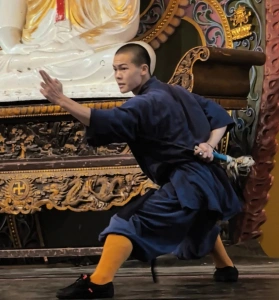
Shaolin Temple Map
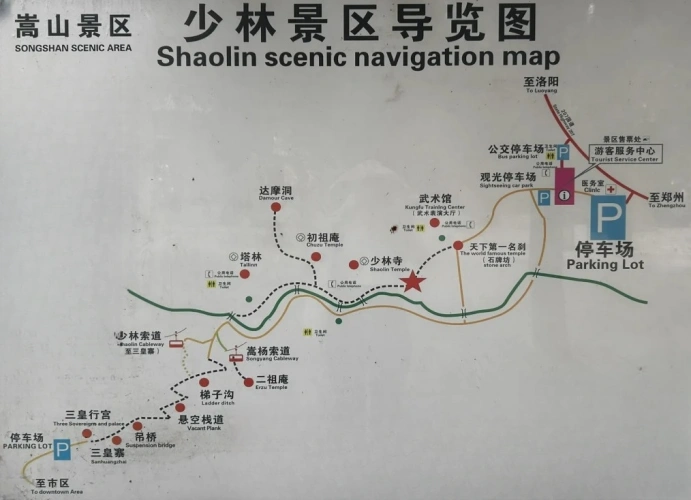
Why You Should Visit Shaolin Temple
Historical Background and Cultural Significance
Shaolin Temple was established in the 19th year of the Taihe era during the Northern Wei Dynasty (495 AD) by Emperor Xiaowen, intended to host the Indian monk Batuo. As the cradle of Chan Buddhism, the temple became renowned for its profound Buddhist heritage and far-reaching historical influence. During the Sui and Tang Dynasties, the temple flourished, especially after the famous story of the “Thirteen Staff Monks Rescuing the Tang Prince,” which earned imperial patronage from Emperor Taizong of Tang. Iconic structures such as the Changzhu Courtyard, Pagoda Forest, and Ancestor’s Niche (First Patriarch Cave) span more than 1,500 years of architectural evolution—from the simplicity of the Northern Wei to the elegance of the Tang and Song Dynasties. Every brick and beam carries layers of Chinese civilization.
Martial Arts Performances and Hands-on Experiences
Shaolin Kung Fu is another major highlight of the temple. Originating from the daily practices of monks, the martial arts focus on real-world combat, with powerful and grounded movements. Visitors can witness performances of Shaolin Fist, staff techniques, and Iron Shirt Qi Gong, and even try basic moves themselves. The temple offers martial arts workshops where travelers can learn techniques like the “Five-Step Fist” and “Damo Staff” and receive a certificate of completion as a “Shaolin Kung Fu Trainee.” Additionally, the temple’s Martial Arts Hall displays ancient weapons, telling the stories of Shaolin warrior monks and their roles in history.
Natural Landscapes and Travel Experience
The natural scenery of Mount Song adds another dimension to your Shaolin Temple journey. In spring, the Forsythia flowers bloom across the hills of Sanhuang Village. Summer brings cool waterfalls along Shaoshi Mountain. In autumn, golden ginkgo trees light up the forest around the Pagoda Forest. Winter transforms the First Patriarch Cave into a snowy wonderland, enhanced by the glow of light shows. Visitors can enjoy hiking trails, admire scenic views, stay in meditation-themed guesthouses, and join Zen retreats. Here, you’ll experience the poetic essence of Chinese spiritual travel—“Lost in the temple’s stillness, facing the silent peaks at sunset.”
Top Things to Do in Shaolin Temple
Main Attractions
Changzhu Courtyard of Shaolin Temple
As the heart of the Shaolin Temple, the Changzhu Courtyard is the first stop for visitors and represents the essence of the entire complex. It was originally built in the 19th year of the Taihe era during the Northern Wei Dynasty (495 AD) and has undergone multiple renovations throughout history. The layout is precise, and the ambiance is solemn, making it the center of monastic life where monks practice, meditate, and teach both Buddhism and martial arts. Once inside, you’ll move through iconic Buddhist structures such as the Mountain Gate Hall, the Hall of Heavenly Kings, the Mahavira Hall, and the Sutra Pavilion. Incense smoke drifts through the air while bells and drums echo gently, and the worn stone paths bear witness to over a thousand years of Chan Buddhism. The murals on the walls and couplets on the pillars are well worth reading slowly—many visitors find their time here to be more than sightseeing; it becomes a spiritual experience.
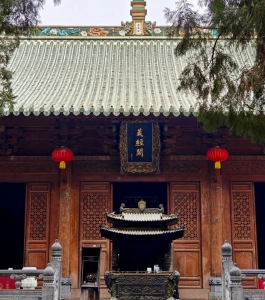
Pagoda Forest
The Pagoda Forest is a cemetery composed of tomb pagodas built for generations of eminent Shaolin monks. With over 240 remaining structures, it is the largest and best-preserved Buddhist pagoda forest in China. It’s not only a showcase of architectural beauty but also a vivid record of Buddhist history. The shape, height, and style of each pagoda reflect the monk’s status, practice, and the culture of the era in which it was built. From the brick pagodas of the Tang and Song Dynasties to the stone pagodas of the Ming and Qing Dynasties, visitors can observe the evolution of architectural style across Chinese history. Walking through the forest feels like stepping into a chronological museum of Chinese Buddhism—profound and awe-inspiring.
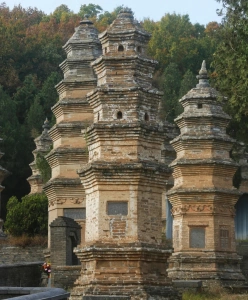
Martial Arts Performance
A visit to the Shaolin Temple wouldn’t be complete without seeing a martial arts performance. Inside the Martial Arts Hall, thrilling Shaolin Kung Fu shows are held daily, drawing both domestic and international visitors. Performances feature fist forms, traditional weapons such as swords and staffs, Iron Shirt techniques, and balance skills on plum blossom piles—each demonstrating the exceptional physical strength and mental discipline of Shaolin monks.
- Free showtimes are held daily at 9:30, 10:30, and 11:30 AM, and again at 2:00, 3:00, and 4:00 PM. The venue is the Martial Arts Hall.
- There are both free and paid versions of the show. If you miss the free one, you can purchase a ticket for the paid version (30 CNY). If you’ve already seen the free show, there’s no need to attend the paid one.
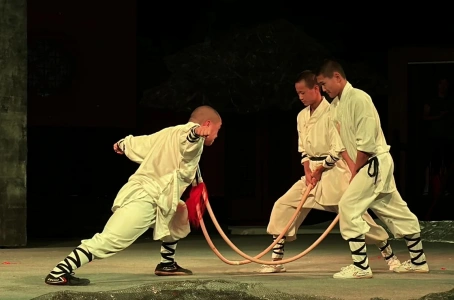
Sanhuang Village
Sanhuang Village features the most stunning natural landscapes within the Shaolin Scenic Area and perfectly blends history, culture, and mountain scenery. According to legend, this is where the Yellow Emperor studied under a master, giving the area its name. Today, it still preserves ancient mountain paths and cliff carvings, making it ideal for hiking, exploration, and discovering traces of the past.
- The Shaolin Temple ticket includes access to Sanhuang Village, so no extra ticket is required.
- Since the area is quite large, it takes around three to four hours to walk the entire trail. Visitors are advised to turn back halfway if pressed for time or physical endurance, as reaching the very end is not necessary for a rewarding experience.
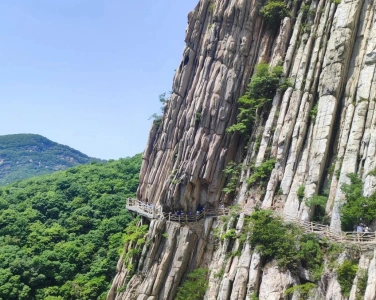
Shaolin Temple Ticket Guide
Shaolin Temple Ticket Prices
- Adults: 80 CNY
- Children/Students: 40 CNY, available to minors under 18 and students enrolled in undergraduate or lower-level programs
- Free admission: Children under 1.4 meters in height and seniors over 60 years old
Ticket Purchase Channels
- Online: WeChat public account or third-party booking platforms
- Ticket Purchase: Trip.com Discounts
- Onsite: Ticket office
Shaolin Temple Tour Guides
Shaolin Temple offers official guided tours that can be booked upon arrival. Once booked, a guide will accompany your group through the temple.
- Location: Tourist Service Center
- Languages: Chinese and English
- Fees: 100 CNY for Chinese-speaking guide (up to 5 people), 300 CNY for English-speaking guide (up to 5 people)
Recommended Route Through Shaolin Temple
The route through Shaolin Temple is relatively linear, so visitors won’t miss the major attractions. Here are the highlights along the way: Changzhu Courtyard → Pagoda Forest → Shaolin Cable Car → Shaoshi Mountain → Martial Arts Performance.
- In the main temple area, you’ll see the Mountain Gate, Hall of Heavenly Kings, Mahavira Hall, Sutra Pavilion, Abbot’s Room, Snow Pavilion, and the Monks’ Practice Hall.
- For food lovers, don’t miss Shaolin Temple Zen Tea (158 CNY per canister) and vegetarian temple meals (around 50 CNY per person for set meals), which offer a unique culinary perspective on temple life.
- From the temple, it’s a short 300-meter walk to the Pagoda Forest—the burial site of generations of monks. It is one of the most intact ancient architectural groups preserved in Chinese Han culture, showcasing a variety of pagoda forms and styles that are key to the Shaolin Temple’s legacy.
- From the Pagoda Forest, it takes only three minutes to reach the Shaolin Cable Car station.
- On the left: The Mount Song Cable Car leads to the Second Patriarch Niche area (round-trip fare: 60 CNY per person)
- On the right: The Shaolin Cable Car leads to Shaoshi Mountain and the Sanhuang Village Scenic Area (round-trip fare: 100 CNY per person)
- For the Shaoshi Mountain visit, take the Shaolin Cable Car for about 10 minutes. From there, a 10-minute walk leads to the cliff path. After another 10 minutes, you’ll arrive at Shuce Cliff and see the famous “Mount Song Stone Bamboo Shoots,” marking the scenic highlight.
- After coming down from the mountain, take a battery-powered shuttle to the Martial Arts Hall to watch the Kung Fu performance.
- Performance times: 9:30, 10:30, 11:30 AM; 2:00, 3:00, 4:00 PM. During holidays with heavy crowds, an extra performance may be added from 5:00–5:30 PM.
- Arrive 10–20 minutes early to secure a spot in line. After the show, a 10-minute walk leads to the scenic area exit, concluding your visit.
Recommended Food Near Shaolin Temple
Don’t miss the chance to try vegetarian cuisine inside the Shaolin Temple.
Shaolin Temple Vegetarian Meal
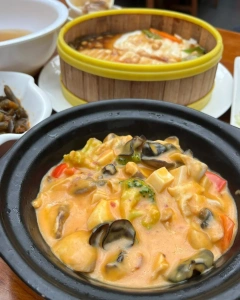
- Why we recommend it: You can choose from set meals or à la carte, and the set menus are highly recommended. They typically include tofu, taro, and a variety of stir-fried vegetables.
- Address: Located right next to the main entrance of Shaolin Temple, look for a place called “Shaolin Huanxidi.” Once inside, the vegetarian restaurant “Shaolin Suzhai” will be on your left.
- Hours: 12:00 PM to 2:30 PM
- Average cost: 50 CNY per person
Recommended Hotels Near Shaolin Temple
We suggest staying near Zhengzhou Railway Station. This area offers a wide range of hotel options, convenient dining, and easy access to both the airport and Shaolin Temple. If you plan to take a tourist shuttle, Zhengzhou Railway Station is well connected to nearly all major attractions.
Tuke China Hotel (Zhengzhou Railway Station Erqi Square Branch)
.webp)
- Transportation: 5-minute walk from Zhengzhou Railway Station
- Price per night: 178 CNY
- Check Rates: Trip Deals
- Rating: 9.4 on Trip
- Special Amenities: Laundry room, robotic room service, family-friendly rooms
The hotel is conveniently located next to the station, just a 5- to 6-minute walk. There’s also a convenience store nearby.
Rooms are spacious, odor-free, and tastefully decorated. Clean bathrooms feature heated toilet seats with sensors. Breakfast is excellent with plenty of variety.
H Hotel (Zhengzhou Railway Station Erqi Square)
.webp)
- Transportation: 5-minute walk from Zhengzhou Railway Station
- Price per night: 226 CNY
- Check Rates: Trip Deals
- Rating: 9.7 on Trip
- Special Amenities: Laundry room, robotic room service
This hotel is very close to the station—just a short walk. It’s also near a local market and food street.
Modern and clean facilities with smart controls for the TV, lighting, and curtains. The bathroom includes hand soap and even laundry detergent.
How to Get from Downtown Zhengzhou to Shaolin Temple
The best way to travel from downtown Zhengzhou to the Shaolin Temple is by tourist shuttle bus, departing from Zhengzhou Central Bus Station (directly across from Zhengzhou Railway Station). If you’re staying elsewhere in the city, take Metro Line 1 or Line 10 to reach the Central Bus Station.
- Departure times: Four departures on weekends at 8:00, 8:30, 9:00, and 9:40 AM; three departures on weekdays
- Return from Shaolin Temple: Three return trips on weekdays and four on weekends, departing at 2:30, 3:30, 4:30, and 5:30 PM. Be aware that 5:30 PM is the last bus back to Zhengzhou.
- Fare: 25 CNY
How to Get from Zhengzhou Xinzheng Airport to Shaolin Temple
The most convenient way to get from Zhengzhou Xinzheng International Airport to Shaolin Temple is by direct tourist bus.
Tourist Shuttle Bus
- Route: Dedicated Mount Song Scenic Area line
- Distance: 137.8 KM
- Duration: Approximately 2 hours and 10 minutes
- Fare: 48 CNY
Taxi or Ride-hailing
If you prefer to take a taxi directly, the total distance is around 126 KM and the ride takes approximately 1 hour and 42 minutes. Estimated fare: 282 CNY
FAQ
Not quite. Although most areas of Shaolin Temple are flat, some parts, such as the martial arts performance area, involve stairs. This makes it inconvenient for strollers and wheelchairs.
Luggage storage is available at the Shaolin Temple Visitor Center. The fee is 15 CNY, with an additional 50 CNY refundable deposit for the key.
Shows take place every day at the Martial Arts Hall. Morning shows are at 9:30, 10:30, and 11:30 AM. Afternoon shows are at 2:00, 3:00, and 4:00 PM.

 English (US)
English (US)  English (Hong Kong)
English (Hong Kong)  English (Malaysia)
English (Malaysia)  English (Singapore)
English (Singapore)  繁體中文
繁體中文 
Comment (0)